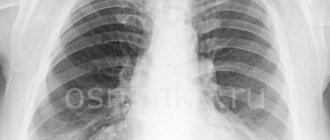Pneumonia (or pneumonia) is an acute respiratory infectious disease that causes damage to the lung tissue. Its main symptoms are cough (dry or with sputum), increased body temperature up to 39 degrees, shortness of breath, chest pain on the affected side, increased sweating and general weakness.
However, as has been revealed with the new COVID-19 infection, the patient may not feel a deterioration in his condition for some time and may not complain of an increase in temperature. In some cases, doctors discovered pneumonia in the later stages, when signs of respiratory failure were already appearing.
Doctors note that the so-called asymptomatic pneumonia is characterized by a hidden course and is a rather serious disease that is difficult to diagnose. However, this disease cannot be called completely asymptomatic.
What is the superbug Klebsiella pneumonia and will antibiotics help with it? More details
How to suspect asymptomatic pneumonia?
In the case of asymptomatic or latent pneumonia, instead of coughing and high fever, the patient may experience decreased mood, fatigue and shortness of breath. The person also experiences rapid breathing and problems with the ability to inhale - lack of air. The patient's skin color may change - the face becomes pale due to lack of oxygen. Another sign is a feeling of high temperature with low levels.
According to the clinical guidelines of the Ministry of Health of the Russian Federation, suspicion of pneumonia should arise if the patient has a fever in combination with complaints of acute cough, shortness of breath, sputum production and/or chest pain associated with breathing or coughing. Patients often complain of unmotivated weakness, fatigue, chills, and severe sweating at night. The development of pneumonia may be preceded by symptoms of damage to the upper respiratory tract (sore throat, runny nose, etc.).
Question answer
Everything you need to know about antibiotics. Infographics In elderly people, complaints characteristic of pneumonia may be absent. The clinical picture of the disease may include symptoms such as drowsiness or anxiety, confusion, anorexia, nausea, and vomiting. Often pneumonia in this category of patients “debuts” with symptoms of decompensation of chronic concomitant diseases (diabetes mellitus, chronic heart failure, etc.). Latent pneumonia can be observed in patients with weakened immune systems.
Main symptoms
The clinical picture, which is most often observed in patients with pneumonia, includes the following components:
- increase in body temperature above 38C,
- severe cough with sputum production,
- chest pain when coughing or taking a deep breath,
- pale skin,
- weakness,
- drowsiness.
Some types of pneumonia cause joint pain, headaches, and red spots on the neck and face. During the examination of the patient, wheezing in the lungs is clearly audible during auscultation. Based on this factor, the doctor has grounds to prescribe additional examination methods, which include radiography.
What tests and examinations should be done if pneumonia is suspected?
The diagnostic algorithm for suspected pneumonia includes anamnesis, assessment of complaints, physical examination, a set of laboratory and instrumental studies, the scope of which is determined by the severity of the disease, as well as the presence and nature of complications and concomitant diseases.
Outpatients with suspected pneumonia are prescribed a complete blood count (with pneumonia, an increased number of leukocytes, an increase in the number of band neutrophils and ESR), pulse oximetry (a diagnostic procedure that allows you to determine blood oxygen saturation) and a plain radiography of the chest organs in frontal and lateral projections. Pneumonia cannot always be detected by conventional chest X-rays, so doctors may perform an X-ray computed tomography (CT) scan on patients with suspected pneumonia. In hospitalized patients, the range of recommended tests additionally includes biochemical blood tests and electrocardiography.
Symptoms, treatment and prevention of pneumonia. Infographics Read more
Age and gender
Initially, the majority of reported cases of COVID-19 in Wuhan were adult patients with radiologically confirmed pneumonia. The mean ages were 49, 55.5 and 56 years in three separate studies. Similar results were observed in two recent studies, one of which included 1,099 patients from 552 hospitals in 31 provinces in China. The average age of the patients was 47.2 years, and 55.1% of patients were aged from 15 to 49 years. A second study, including 4021 confirmed cases in 30 provinces in China, found that the average age was 49 years and 50.7% of patients were between 20 and 50 years of age. Both of these studies included cases of clinical manifestations of acute respiratory infections and pneumonia. Similarly, the China Emergency Surveillance Team reported that 66.7% (n = 29,798) of 44,672 COVID-19 cases of varying severity were diagnosed between 20 and 60 years of age. In Korea, Ryu et al. found that the first 15 cases reported were between 25 and 62 years of age. Regarding elderly patients infected with SARS-CoV-2, one study found that 14.6% (6 of 41) of patients were aged ≥ 65 years, another group of researchers also indicated that among cases of pneumonia, 15.2% ( 15 of 99) patients were aged ≥ 70 years. In addition, two unconfirmed studies to date have shown that only 153 (15.1%) patients were elderly, aged ≥ 65 years in the first study and 407 (10.1%) patients were aged >70 years in the second.
According to a recent report from the CDC in China, 12.0% (n = 5326) of patients were aged ≥ 70 years. Regarding children with confirmed COVID-19, one study found 9 people over 10 years of age, representing 0.9%, while 14 (0.35%) patients aged ≤ 10 years were reported in another study . The largest study to date in China found that 0.9% (n = 416) of patients were aged <10 years. Next, Wei et al. reported that 9 children under 1 year of age were infected with SARS-CoV-2 in China. Focusing on the gender ratio of patients, in most studies, men accounted for more than half of the cases (the proportion of male patients ranged from 51.4 to 73.2%). In terms of transmission, most transmission of the virus occurs from person to person. Fortunately, to date there has been no evidence of intrauterine infection due to vertical transmission in women who have had COVID-19 pneumonia in late pregnancy. The situation with the transmission of a new infection is complicated by the nosocomial spread of SARS-CoV-2, which is a serious problem. Indeed, one study from Wuhan University Zhongnan Hospital found that 29.0% (n = 40) of those infected were medical staff, and 12.3% (n = 17) became ill with COVID-19 during hospitalization. Two other studies found that 2.1% (n = 23) and 3.8% (n = 1716) of patients were healthcare workers.
Risk groups for developing pneumonia
Although pneumonia is possible in any person, there are risk groups among whom inflammation occurs much more often, has a more serious severity and unfavorable prognosis (especially if treatment is delayed). The category of people most susceptible to complications of respiratory pathologies with the development of pneumonia and respiratory failure includes:
- infants in the first weeks of life, premature babies, low birth weight babies;
- elderly people (over 65 years old);
- persons with chronic diseases of the bronchopulmonary system (COPD, bronchitis, emphysema, alveolitis, asthma) or pathologies of the cardiovascular system;
- patients with severe liver and kidney damage and alcoholism;
- people with metabolic and endocrine disorders (diabetes, obesity, thyroid and adrenal problems);
- children and adults with primary and secondary immunodeficiencies;
- cancer patients;
- persons with serious autoimmune disorders, especially those receiving immunosuppressive drugs.
In addition, lifestyle, diet, constant lack of sleep and chronic stress, which undermine the functioning of the immune system, have a significant impact. Source: Cilloniz C, Martin-Loeches I, Garcia-Vidal C, San Jose A, Torres A. Microbial Etiology of Pneumonia: Epidemiology, Diagnosis and Resistance Patterns // Int J Mol Sci. 2021 Dec 16;17(12):2120. doi: 10.3390/ijms17122120..
Pneumonia: symptoms and signs in an adult
Pneumonia usually occurs as a complication of acute respiratory viral infections and various infections, including coronavirus and influenza. The first signs of damage to the lung tissue are coughing, wheezing, increased breathing, shortness of breath at rest and with slight exertion, cyanosis of the nasolabial triangle, nails, pallor of the skin and a decrease in oxygen saturation (percentage of oxygen saturation in the blood). Additional signs may be general weakness, malaise, fever, loss of appetite, sweating, nausea, pain in the upper abdomen when breathing. It is important to emphasize that in some cases inflammation is possible without fever. Therefore, it is important to see a doctor - it is the specialist who makes the diagnosis, he knows how to identify the inflammatory process during examination. But it is important to confirm the diagnosis with X-ray or CT data.
Certain variants of the disease, classified as atypical according to the classification, can be carried on the legs (walking pneumonia caused by mycoplasma), but whether pneumonia can go away on its own depends on age, health status and the type of pathogen, and the characteristics of the pathogenesis of the infection.
Drugs for the treatment of pneumonia
It is important to remember that pneumonia cannot be treated on your own. This disease is too dangerous to be treated at home or to be carried on your feet. Treatment of pneumonia is carried out under the supervision of a general practitioner or pulmonologist in a hospital setting.
The main method of treating pneumonia without fever and cough is antibacterial therapy. The patient is prescribed antibacterial drugs for a course of 10-14 days. Most often, antibiotics are administered intramuscularly.
Additionally, expectorants are prescribed to thin and remove mucus from the lungs. Bronchodilators are used to eliminate shortness of breath. Inhalations have a good therapeutic effect. With the development of asymptomatic pneumonia, various warming of the chest, baths, saunas, and hot baths are strictly prohibited.
A patient with pneumonia should eat well, drink enough fluids, and take multivitamins. Some time after starting to take antibiotics, physiotherapeutic procedures are included: massages and therapeutic breathing exercises.
Get treatment at the Yusupov Hospital
Pneumonia without fever is a dangerous pathology that requires immediate treatment, which can prevent the development of disastrous consequences. At the first symptoms of the disease, you must seek qualified medical help.
Timely and well-chosen therapy guarantees a favorable prognosis for the disease. Successful treatment of pneumonia without fever is carried out at the Yusupov Hospital. The clinic's therapists and pulmonologists have extensive experience in diagnosing and eliminating various types of pneumonia. The Yusupov Hospital provides patients with comfortable hospital rooms, where they have everything they need for a quick recovery.
The Yusupov Hospital is located near the center of Moscow and provides care to patients around the clock. You can ask for advice, make an appointment and get recommendations from specialists by phone.
Immunomodulatory and antioxidant therapy
Most latent pneumonia develops against the background of reduced immunity. The body's protective functions are disrupted during a protracted course of the disease. Antibacterial agents used for pneumonia also affect nonspecific defense mechanisms and the state of the immune system. Most beta-lactam antibiotics significantly enhance phagocytosis. Cephalosporins (cefodizim, cefaclor) have an immunomodulatory effect. Macrolides reduce the resistance of bacteria to the action of bactericidal factors. Fluoroquinolones enhance immunity. Doctors at the Yusupov Hospital take these features of antibacterial drugs into account when choosing antibiotics for the initial treatment of latent pneumonia.
For latent pneumonia in adults, the following immunocorrective agents are used:
- prodigiosan;
- T-activin;
- anabol;
- zaditen;
- diuciphone.
Immunocorrective drugs for sharply reduced levels of individual parts of the immune system are prescribed even in the initial period of the infectious process. They are also indicated during the recovery stage. Interferon preparations are also used as immunomodulatory agents. In the complex therapy of latent pneumonia, especially with a prolonged course, immunomodulatory methods such as laser and ultraviolet irradiation of blood are used. They allow you to quickly improve your immune status.
To correct membrane disorders that occur with asymptomatic pneumonia, pulmonologists prescribe an exogenous antioxidant - vitamin E. For the same purpose, Essentiale in capsules is included in the complex therapy of latent pneumonia. Emoxipine is used as antioxidant therapy. The drug is administered intravenously in an isotonic sodium chloride solution.







